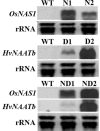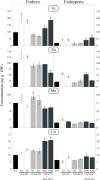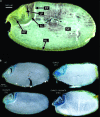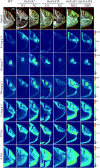Iron and Zinc in the Embryo and Endosperm of Rice (Oryza sativa L.) Seeds in Contrasting 2'-Deoxymugineic Acid/Nicotianamine Scenarios
- PMID: 30186295
- PMCID: PMC6113566
- DOI: 10.3389/fpls.2018.01190
Iron and Zinc in the Embryo and Endosperm of Rice (Oryza sativa L.) Seeds in Contrasting 2'-Deoxymugineic Acid/Nicotianamine Scenarios
Abstract
Iron and Zn deficiencies are worldwide nutritional disorders that can be alleviated by increasing the metal concentration of rice (Oryza sativa L.) grains via bio-fortification approaches. The overproduction of the metal chelator nicotianamine (NA) is among the most effective ones, but it is still unclear whether this is due to the enrichment in NA itself and/or the concomitant enrichment in the NA derivative 2'-deoxymugineic acid (DMA). The endosperm is the most commonly consumed portion of the rice grain and mediates the transfer of nutrients from vegetative tissues to the metal rich embryo. The impact of contrasting levels of DMA and NA on the metal distribution in the embryo and endosperm of rice seeds has been assessed using wild-type rice and six different transgenic lines overexpressing nicotianamine synthase (OsNAS1) and/or barley nicotianamine amino transferase (HvNAATb). These transgenic lines outlined three different DMA/NA scenarios: (i) in a first scenario, an enhanced NA level (via overexpression of OsNAS1) would not be fully depleted because of a limited capacity to use NA for DMA synthesis (lack of -or low- expression of HvNAATb), and results in consistent enrichments in NA, DMA, Fe and Zn in the endosperm and NA, DMA and Fe in the embryo; (ii) in a second scenario, an enhanced NA level (via overexpression of OsNAS1) would be depleted by an enhanced capacity to use NA for DMA synthesis (via expression of HvNAATb), and results in enrichments only for DMA and Fe, both in the endosperm and embryo, and (iii) in a third scenario, the lack of sufficient NA replenishment would limit DMA synthesis, in spite of the enhanced capacity to use NA for this purpose (via expression of HvNAATb), and results in decreases in NA, variable changes in DMA and moderate decreases in Fe in the embryo and endosperm. Also, quantitative LA-ICP-MS metal map images of the embryo structures show that the first and second scenarios altered local distributions of Fe, and to a lesser extent of Zn. The roles of DMA/NA levels in the transport of Fe and Zn within the embryo are thoroughly discussed.
Keywords: laser ablation; ligands; mass spectrometry; metals; rice; seeds.
Figures







Similar articles
-
The ratio of phytosiderophores nicotianamine to deoxymugenic acid controls metal homeostasis in rice.Planta. 2019 Oct;250(4):1339-1354. doi: 10.1007/s00425-019-03230-2. Epub 2019 Jul 5. Planta. 2019. PMID: 31278466
-
Phytosiderophores determine thresholds for iron and zinc accumulation in biofortified rice endosperm while inhibiting the accumulation of cadmium.J Exp Bot. 2017 Oct 13;68(17):4983-4995. doi: 10.1093/jxb/erx304. J Exp Bot. 2017. PMID: 29048564 Free PMC article.
-
Constitutive overexpression of the OsNAS gene family reveals single-gene strategies for effective iron- and zinc-biofortification of rice endosperm.PLoS One. 2011;6(9):e24476. doi: 10.1371/journal.pone.0024476. Epub 2011 Sep 6. PLoS One. 2011. PMID: 21915334 Free PMC article.
-
A tale of two metals: Biofortification of rice grains with iron and zinc.Front Plant Sci. 2022 Nov 7;13:944624. doi: 10.3389/fpls.2022.944624. eCollection 2022. Front Plant Sci. 2022. PMID: 36420033 Free PMC article. Review.
-
Exploiting new tools for iron bio-fortification of rice.Biotechnol Adv. 2013 Dec;31(8):1624-33. doi: 10.1016/j.biotechadv.2013.08.012. Epub 2013 Aug 22. Biotechnol Adv. 2013. PMID: 23973806 Review.
Cited by
-
A genome-wide association study identifies a transporter for zinc uploading to maize kernels.EMBO Rep. 2023 Jan 9;24(1):e55542. doi: 10.15252/embr.202255542. Epub 2022 Nov 17. EMBO Rep. 2023. PMID: 36394374 Free PMC article.
-
Strategies and Bottlenecks in Hexaploid Wheat to Mobilize Soil Iron to Grains.Front Plant Sci. 2022 Apr 29;13:863849. doi: 10.3389/fpls.2022.863849. eCollection 2022. Front Plant Sci. 2022. PMID: 35574143 Free PMC article. Review.
-
Genome-wide analysis of the NAAT, DMAS, TOM, and ENA gene families in maize suggests their roles in mediating iron homeostasis.BMC Plant Biol. 2022 Jan 17;22(1):37. doi: 10.1186/s12870-021-03422-7. BMC Plant Biol. 2022. PMID: 35039017 Free PMC article.
-
Concomitant Activation of OsNAS2 and OsNAS3 Contributes to the Enhanced Accumulation of Iron and Zinc in Rice.Int J Mol Sci. 2023 Mar 31;24(7):6568. doi: 10.3390/ijms24076568. Int J Mol Sci. 2023. PMID: 37047538 Free PMC article.
-
Investigation of Genotype by Environment Interactions for Seed Zinc and Iron Concentration and Iron Bioavailability in Common Bean.Front Plant Sci. 2021 May 10;12:670965. doi: 10.3389/fpls.2021.670965. eCollection 2021. Front Plant Sci. 2021. PMID: 34040625 Free PMC article.
References
-
- Anderegg G., Ripperger H. (1989). Correlation between metal complex formation and biological activity of nicotianamine analogues. J. Chem. Soc. Chem. Comm. 1989 647–650. 10.1039/c39890000647 - DOI
-
- Ando Y., Nagata S., Yanagisawa S., Yoneyama T. (2013). Copper in xylem and phloem saps from rice (Oryza sativa): the effect of moderate copper concentrations in the growth medium on the accumulation of five essential metals and a speciation analysis of copper-containing compounds. Funct. Plant Biol. 40 89–100. 10.1071/FP12158 - DOI - PubMed
-
- Anuradha K., Agarwal S., Batchu A. K., Babu A. P., Mallikarjuna Swamy B. P., Longvah T., et al. (2012). Evaluating rice germplasm for iron and zinc concentration in brown rice and seed dimensions. J. Phytol. 4 19–25.
-
- Banakar R., Álvarez-Fernández A., Abadía J., Capell T., Christou P. (2017a). The expression of heterologous Fe (III)-phytosiderophore transporter HvYS1 in rice increases Fe uptake, translocation and seed loading and excludes heavy metals by selective Fe transport. Plant Biotechnol. J. 15 423–432. 10.1111/pbi.12637 - DOI - PMC - PubMed
LinkOut - more resources
Full Text Sources
Other Literature Sources

